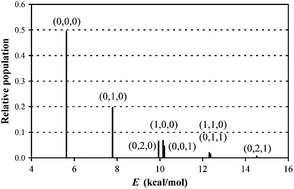Product vibrational distributions in polyatomic species based on quasiclassical trajectory calculations
Abstract
By including anharmonicity and Coriolis coupling terms, we have improved our earlier quasi-classical method for vibrational mode analysis in polyatomic species, which was based on a harmonic approach. Because accurate methods have been developed only for diatomic and triatomic systems, the new algorithm was tested against accurate methods for diatomic molecules, and against the semiclassical fast Fourier transform (FFT) method for triatomic species, finding excellent agreement. The new algorithm is designed to be used with dynamics studies based on quasi-classical trajectory (QCT) calculations, and it is general for any polyatomic species.


 Please wait while we load your content...
Please wait while we load your content...